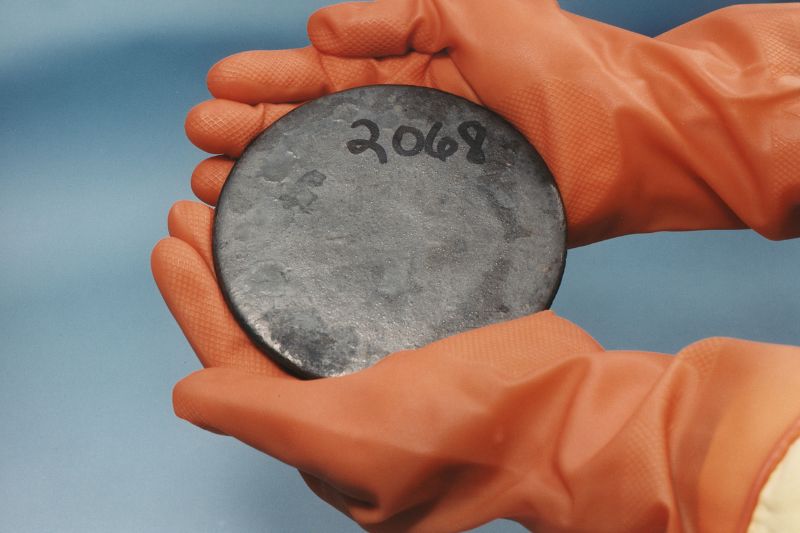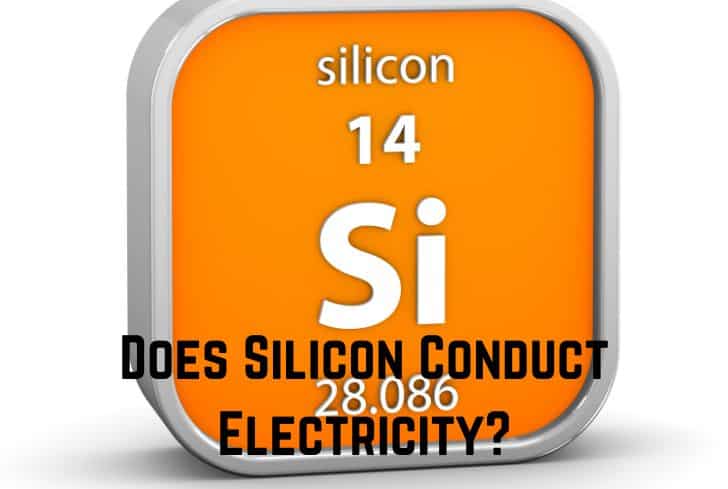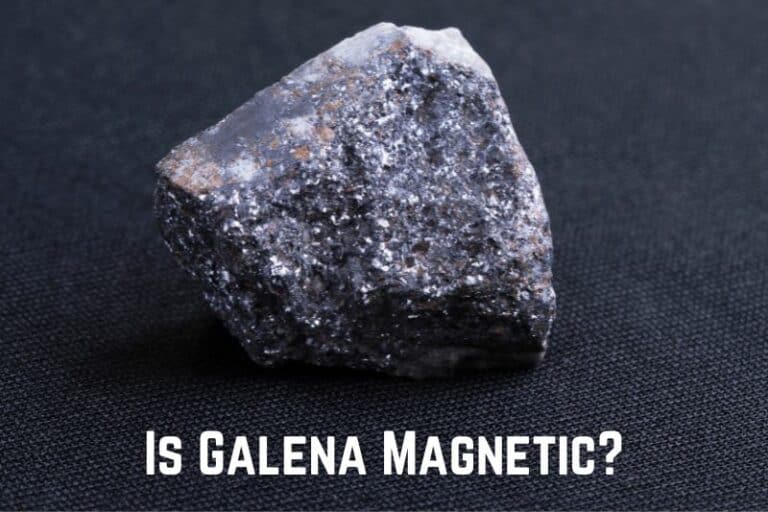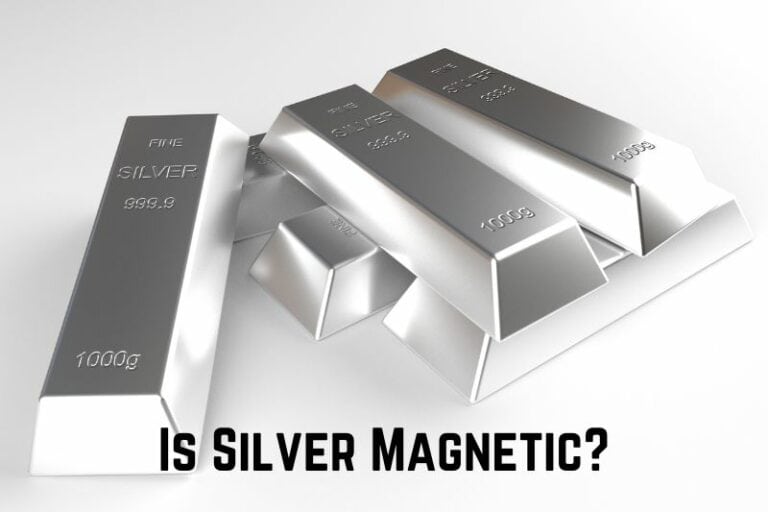Is Uranium Magnetic? (Answered)

Did you know uranium has the highest atomic weight among all naturally occurring elements? It’s 9 times heavier than gold and 40 times heavier than lead. The name of the element, uranium, commonly used to make nuclear weapons, originates from the planet Uranus. However, you might also be curious about its magnetism. Therefore, is uranium magnetic?
We begin by addressing whether uranium is attracted to a magnet in this article. However, continue reading to find out if uranium, uranium oxide, and depleted uranium are magnetic. Learning whether uranium is an element, compound, or mixture will also be interesting. Finally, we look at uranium’s properties and uses.
Read: Is Graphene Magnetic?
Is Uranium Attracted to a Magnet?
Uranium has a weak magnetic field. It produces a weak dipolar magnetic field due to being paramagnetic. As a result, uranium has a slight magnetic attraction to a magnet but loses its magnetic abilities when the magnet is removed. Since the temperature impacts the magnetic properties of paramagnetic materials, uranium, when cold, will be strongly attracted to a magnet.
However, uranium’s magnetism is extremely low and can only be detected by specialized equipment. As a result, while uranium can attract a magnet, it can’t function as a magnet by itself.
When exposed to an external magnetic field, the magnetic fields within a paramagnetic material are arranged in the same direction as the applied field. A paramagnetic material loses its magnetism when you remove the applied magnetic field.
The video below demonstrates the magnetism of 40 different metals in addition to uranium.
Uranium-238 (146 neutrons and higher), which makes up more than 99% of the uranium on Earth, is one of the two most common naturally occurring uranium isotopes. The sole naturally occurring isotope is uranium-235, which possesses 143 neutrons. So, the most common isotope used in nuclear weapons and power plants is uranium-235. The main reason behind this is that it can engage in nuclear fission.
Is Uranium Oxide Magnetic?
Uranium oxide (UO2 ) is antiferromagnetic. Its net magnetic moment is zero because the magic moments of its atoms or ions align in opposing directions. This results from an exchange contact between nearby atoms, which choose anti-parallel alignment to use as little energy as possible. Consequently, it doesn’t generate a magnetic field of its own.
Uranium oxide, however, shows paramagnetism properties at its Néel temperature. At low temperatures, its atoms align in the opposite direction; however, beyond its Néel temperature, they realign in the same direction. Antiferromagnetic materials, on the other hand, are less common and are typically found at low temperatures.
A table showing the various types of uranium oxide.
| Uranium oxides | |
| -Uranium dioxide | -Diuranium pentoxide |
| -Uranium trioxide | -Truranium octoxide |
| -Uranyl peroxide | -Amorphous uranium (IV) oxide |
We highlight some of the properties of uranium oxide:
- It has a high melting point of 5072°F ((2800°C).
- Uranium oxide has excellent irradiation stability.
- Has chemical stability but poor thermal conductivity.
- Ease of fabrication and compatibility with cladding.
Is Depleted Uranium Magnetic?
Depleted uranium is weakly paramagnetic. The paramagnetism of depleted uranium remains even at low temperatures. Four unpaired electrons are created by the unpaired electrons from the oxygen (2) and uranium (2) atoms. These electrons operate like tiny magnets. When an external magnetic field is applied, the electrons spin parallel to the magnetic field.
Most of the uranium-235 in the natural uranium ore is taken out, leaving behind depleted uranium (DU). Compared to natural uranium, DU has lower radioactivity.
It is commonly used as counterweights for aircraft and ballast for ships since it is a dense metal that is 1.7 times as dense as lead. Also used in ammunition as bullets and mortar shells. Did you know it can be used in bombs and shells that penetrate armor during the war? Compared to typical hard-rolled steel armor plates, depleted uranium armor is more resistant to being penetrated by anti-armor ammunition.

Is Pure Uranium Magnetic?
Pure uranium is paramagnetic. The outer shell of uranium has two valence electrons and four unpaired electrons. Magnetic moments are produced by the free electrons when they spin and move freely. Magnetic moments refer to each particle’s magnetic direction.
The magnetic dipoles of uranium are parallel to the magnetic field direction, increasing magnetism.
However, there are a few interesting facts about paramagnetic materials, Uranium being one of them. Below, we highlight the following:
- A powerful magnet slightly attracts paramagnetic materials.
- When exposed to a non-magnetic field, paramagnetic materials go from a weak to a strong field area.
- Paramagnetic materials’ magnetization is inversely related to their absolute temperature. That means the more the temperature of uranium increases, the more its magnetism decreases.
- Inside paramagnetic materials, magnetic field lines get denser.
- Positive and small magnetic susceptibility is present.
- About one-third of the magnetic dipoles are aligned with the applied field, a tiny percentage. The alignment adds an extra magnetic field, strengthening the applied field and the magnetic field produced by each dipole.
Is Uranium an Element, Compound, or a Mixture?
Uranium is a metallic element. The uranium atom is the only type of atom that makes up the uranium metal. It doesn’t split into separate, less complex compounds. As one of the “rare earth elements” in Group Three of the periodic table, uranium is also categorized as an element in the Actinide series.
Uranium ore, however, is a mixture. Uraninite, sometimes referred to as pitchblende, is the main type of uranium ore. It primarily comprises uranium, oxygen, and trace amounts of thorium, lead, helium, and other rare earth elements. All uraninite minerals also contain a small amount of radium as radioactive decay. Hence, making uranium ore a compound.
Properties of Uranium
Uranium is a naturally occurring element. It has the largest atomic mass of any naturally occurring element and is more abundant than silver. These are not the sole properties of uranium, though. The chemical and physical characteristics of uranium are highlighted below.
Physical Properties
- It is paramagnetic and has an orthorhombic crystal structure.
- Uranium is malleable and ductile
- It has a hard, metallic density.
- Uranium metal has a little yellowish tint and is silvery white.
- It is extremely radioactive and does not corrode, tarnish, or rust.
- Uranium exists in different forms known as “isotopes.” The number of uncharged particles in the nucleus makes these isotopes different.
Chemical Properties
- Its chemical symbol is U, with an atomic number of 92.
- In acids, uranium dissolves and interacts with the water.
- A poor heat conductor.
- The melting and boiling points of uranium are 2070 °F (1132 °C) and 6904 °F (3818 °C), respectively.
- Except for noble gases, it reacts with practically all non-metals and their compounds, and its reactivity increases with temperature.
Uses of Uranium
Uranium can be found in soil, rock, and water in small amounts. However, it is also produced commercially from uranium-rich rocks like uraninite. Uranium is also mined from open pits or underground excavations. The uranium is then extracted from the ore by crushing and processing it in a mill.
| Industry | Characteristics |
| Nuclear | -Industrial reactors. |
| -Nuclear fuel is used in nuclear power plants to generate energy. | |
| -The creation of hydrogen bombs. | |
| -The development of nuclear weapons. | |
| Medical | -Cancer therapy. |
| -High-intensity X-rays | |
| -Inertial guiding systems and gyroscopic compasses | |
| Electrical | -Uranium fuel produces heat to create steam that turns turbines and produces electricity. |
| -Use as an attachment to lightbulb filaments. | |
| Military | -Can make counterweights of aircraft contro surfaces and radiation shielding. |
| -Creating penetrators with high density. | |
| -Depleted uranium is used to harden removable vehicle armor, such as tank armor. | |
| -Some radioactive material storage and transportation containers use depleted uranium as a shielding material. | |
| -Used as a shielding material and ballast for missile re-entry vehicles. | |
| Others | -Dyes and stains for the wood and leather various industries. |
| -Glass and ceramic coloring agents. | |
| -As a dyeing process mordant. | |
| -Radium extraction. |
Read: Is Paper an Insulator? (Answered)
Conclusion
Uranium is paramagnetic with a weak magnetic field. Similarly, so is depleted uranium. On the other hand, uranium oxide starts as antiferromagnetic at lower temperatures. Uranium oxide acquires paramagnetic properties when it reaches Néel temperature.
Frequently Asked Questions
What happens if you break uranium?
Protactinium, a radioactive material, forms when uranium breaks down. Thorium is another radioactive byproduct of protactinium. Radon gas forms when thorium and radium react.
The breakdown of radon gas atoms produces six radioactive compounds called radon daughters or radon progeny. Lead forms as the final by-product, a more stable but toxic final product.
What rocks are rich in uranium?
Igneous, metamorphic, sedimentary, and numerous more types of rocks that belong to these classifications are known to contain uranium ore deposits.
Granite, monzonites, pegmatite, and alaskite are uranium-rich rocks. The majority of uranium resources are contained in intrusive deposits. Most of the uranium produced worldwide comes from Kazakhstan, Canadian, and Australian mines.
What color is uranium when it glows?
Regardless of the color, uranium glass emits neon green when exposed to ultraviolet (UV) light. The only reliable way to recognize genuine radioactive uranium glass is with ultraviolet light.
A glass that contains uranium oxide that glows under a black light is referred to as “uranium glass” in most situations. Vaseline and depression glass are two additional common names for glass. The uranium glass’s eerie brightness and apparent danger have attracted many collectors, making it highly popular.






